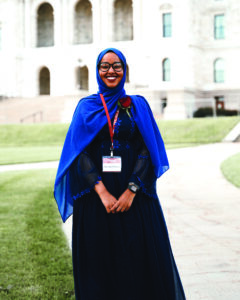
Qorsho Hassan knows what it’s like to feel invisible at school, and because of that, she has spent the last eight years making sure no student feels the same way.
“A lot of my teachers didn’t reflect me and didn’t create space for me to be my authentic self,” she said. “I’ve learned that I create a space where students can be themselves. They don’t see their assets as deficits.”
Hassan, who is Somali and Muslim, knows that for many of her students, she is a mirror, and for others, she is a window.
“We are windows to students to see a different culture, and then serve as mirrors to those students who haven’t seen themselves in professions like teachers,” she said.
This focus on equity and supporting all students is a big reason why Hassan was named the 2020 Minnesota Teacher of the Year this August.
Hassan is a fourth-grade teacher in Rosemount-Apple Valley-Eagan.
As the 2020-21 school year began, she was teaching in a hybrid model, which made her focus on meeting students’ and families’ needs even more necessary.
“With COVID-19, we’re making a lot of changes with how we reach students and families,” she said. “The parents and community are reaching out more. As teachers, we have been pretty good at advocating for services. But we want to be intentional about how we advocate. Things haven’t always been equitable for our students of color. Teachers need to be allies for communities of color and students of color.”
That is something Hassan does through relationship building and creating spaces where students can thrive.
“Qorsho is able to quickly form meaningful, authentic and sustaining relationships with students and families,” said Dr. Chris Bellmont, principal at Gideon Pond Elementary in Burnsville, where Hassan taught last year. “She is then able to use strong, effective and innovative instructional strategies to leverage positive relationships into profound learning experiences. Qorsho’s classroom is vibrant, engaging, and features students using each other as resources to support learning.”
Hassan knows that if students feel seen and heard, their educational achievements are much greater.
“I build strong relationships in order to know every single student as an individual,” she said in her Teacher of the Year selection materials. “I use deescalation techniques to make sure my students feel valued even in their most challenging moments. By having high expectations and standards for all my students, I am able to see academic growth and progress as well as improvement in confidence and communication. I challenge systems of oppression such as poverty and racism by demanding more resources for my students and their families.”
And as an educator of color, Hassan wants her peers to be seen and heard as well.
“Research proves that teachers of color are good for all students and even better for white students. However the retention of teachers of color is very low in Minnesota and the support provided to them is inadequate,” she said. “I believe more leaders of color need access to spaces of decision-making in order to correctly address and fix implicit bias, systemic and structural racism. They will be able to dismantle the very system that holds students and communities of color back.”
The COVID-19 pandemic and being at the epicenter of the racial justice reawakening has only magnified how educators and classrooms need to be a place for all voices and conversations, Hassan said.
“As educators, we have a wonderful platform to expose students to the world that may be broader than what they experience,” she said. “As educators, we have that power. And we need to use that power for good.”


